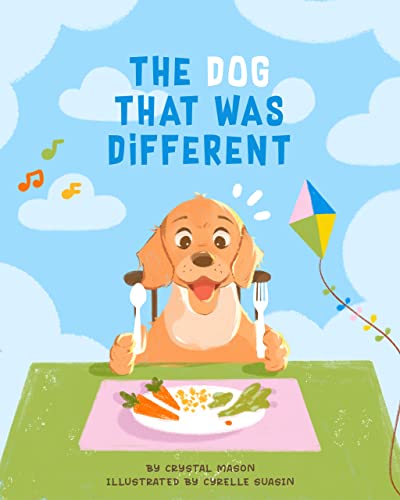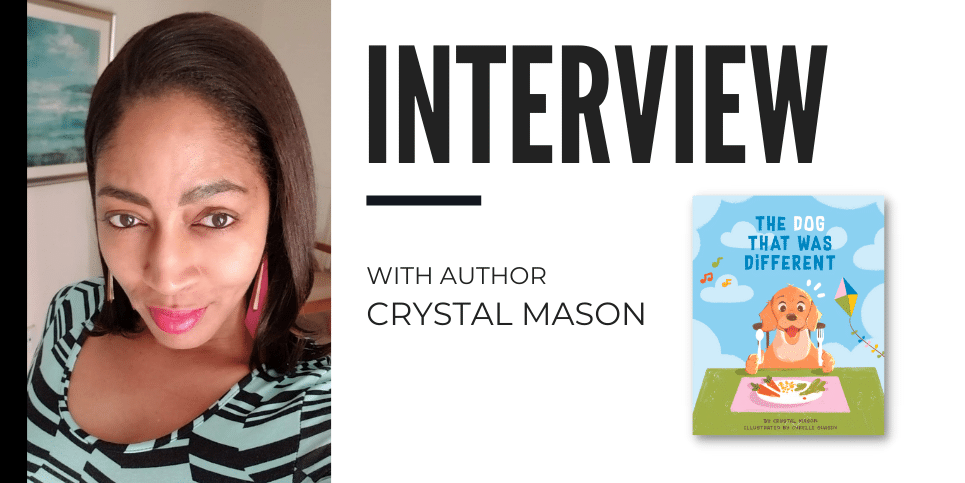The Children’s Book Review Interview in partnership with Crystal Mason, author of The Dog That Was Different
Crystal Mason started her writing journey with poetry, then transitioned into narrative writing. She completed a program in elementary education at Western Governors University, and she plans to teach the second grade. She enjoys working with children, and her goal, outside of teaching, is to continue writing stories that are inspiring and entertaining to her readers.
In this interview, we talk about her picture book, The Dog That Was Different, a story about understanding and accepting difference as something to celebrate.
Dr. Jen Harrison: What inspired you to start writing books for children?
Crystal Mason: Prior to writing stories for children, I wrote poetry along with a few unpublished fiction titles for adults. I transitioned from those areas after working as a substitute teacher and hearing the laughter ringing out from children while reading them entertaining books; the laughter gave me much joy, and I was inspired to start writing children’s stories. It gave me a new sense of purpose, and it connected well with my teaching profession.
What made you want to write a story about being different and accepting differences in others?
I love to write entertaining stories that make children laugh, but I also think it’s important to have a central message that children/people can relate to. Also, considering I’m in the teaching field, it was important that my book aligned with academic standards so it could be incorporated into a school’s curriculum. In this story, the central message is acceptance. Acceptance, as well as empathy, can be topics of discussion in teaching lessons as it pertains to this story.
In addition, this narrative story is good for character building; it aids students in making connections and learning how to treat others
Golden’s behavior is really very different! Is he based on a real dog?
No, Golden was not based on a real dog.
What was your inspiration for some of his quirks?
Humans were my inspiration. Thus, I made him act like a human; we all know that dogs don’t use the commode, eat with a fork, etc. This is why this story is entertaining. Children get to see a dog acting like a human, which may seem silly and/or funny to them.
Why did you choose to use a dog rather than other children to illustrate your message about difference and acceptance?
I thought it would be more entertaining to use a dog.
Do you think pets play an essential role in helping children learn about empathy? Why (or why not)?
I think it depends on the upbringing and personal experiences of a child. For example, the boy in my book was able to make the connection regarding empathy as a result of his negative school experience. Also, if a child was not reared in a household with animals and/or the child doesn’t really care for animals, there’s less likelihood of the child learning about empathy as it relates to animals.
You kept the illustrations for this story simple. Can you tell us a little bit about that design choice? How do you feel that the images support the message in the story?
I wanted the characters to stand out in the story and look like real humans/animals, which I believe is accomplished. The images support the message because you have a dog doing unconventional things, which do not fit the mold of a typical dog. Also, there’s an image where the reader can see how the boy is able to make a connection, which led him to experience empathy, thus leading to acceptance of his dog.
John’s mom is hands-off mainly in the story, but she’s always there with words of wisdom when John needs them. Is there a message in this story for parent readers and child readers?
John’s mom bought Golden for him because he wanted a dog. However, it was his responsibility to take care of the dog. His mom helped to reinforce the message about acceptance throughout the book (in her talks with John) as it related to the dog and John. The central message for parents and children was primarily about acceptance.
What would you recommend to readers who enjoyed your book and would like to read more about accepting differences?
I would recommend that readers continue seeking out books and/or alternative ways to reinforce the message. Also, it would be great to pass along and/or get the word out to other readers who you think would enjoy and benefit from the message. There are platforms such as Goodreads and other social media sites where books are recommended to readers. You can search out the genre, etc. That’s one way to find what you’re looking for.
Do you have any recommendations for educators who want to include your book in an “inclusivity” curriculum? What are some ideas for using the book in the classroom?
This story can be used in Language Arts lessons (in reading and writing) involving recounting the beginning, middle, and ending of a story to help find the theme/central message. Students can be taught how to write a narrative story by using a graphic organizer to come up with a topic, title, and details (eg: setting, characters, sequence of events, etc) for their story. I would use my book to model how to complete the organizer, so students would have a reference to go by when completing their organizer.
In another lesson, students would transfer their ideas from the organizer onto writing paper, making sure the details were cohesive, made sense, and in the right order. These are just a few ways. There are a lot of creative ways to include my book in lessons.
Will there be other stories about John and Golden?
No, there will not be other stories about this duo.
For more information, visit https://crystaldawnwrites.com/.

The Dog That Was Different
Written by Crystal Mason
Illustrated by Cyrelle Suasin
Ages 3-7 | 25 Pages
Publisher: Crystal Mason | ISBN-13: 9798418565174
Publisher’s Synopsis: Golden is a golden retriever who is not like other dogs. For example, he likes to read the newspaper while sitting on the commode. Well, he tries to read the newspaper. His owner, whose name is John, is fed up with him; he just wants a normal dog. During John’s struggle to change Golden, he gets a dose of his own medicine, which gives him a new perspective toward Golden’s behavior.
Buy the Book
This interview—Crystal Mason Discusses The Dog That Was Different—was conducted between Crystal Mason and Dr. Jen Harrison. For similar books and articles, follow along with our content tagged with Acceptance, Diversity, Dogs, and Picture Book.

